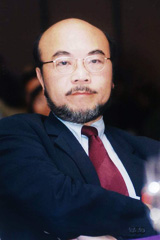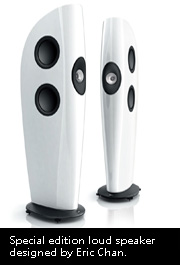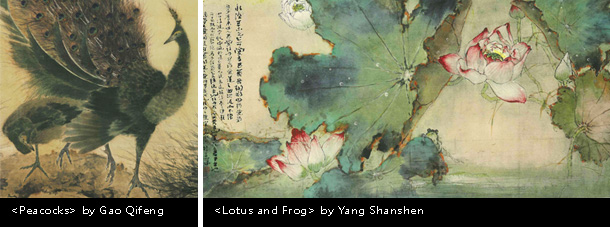Talking Art: Victor Lo
 Give him a pencil but take away his suit, Mr. Victor Lo should look more like an acclaimed artist than a businessman. The WKCD Board member and Chairman of the Museum Committee has always been an art lover since he was a child. Despite his family business involvement, Victor has never compromised his passion for arts. His undying persistence can be shown in his choice of university major, the various public duties he currently holds and his private collection at home. Give him a pencil but take away his suit, Mr. Victor Lo should look more like an acclaimed artist than a businessman. The WKCD Board member and Chairman of the Museum Committee has always been an art lover since he was a child. Despite his family business involvement, Victor has never compromised his passion for arts. His undying persistence can be shown in his choice of university major, the various public duties he currently holds and his private collection at home.
Q: When was your first encounter of art?
A: When I studied at Tak Yan Primary School, I really enjoyed painting and my works were at times displayed on the school board. I wished I could become an artist. However, my parents tended to think an artist could not make ends meet. Therefore, I compromised slightly to study Industrial Design at the Illinois Institute of Technology, which was not just relevant to my family business but also satisfied my artistic desire.
Q: So painting is your favorite form of art?
A: Not only painting, I’d say visual art because I also like sculpture and photography. I seldom paint now, but still draw product design board at work. I’ve always enjoyed photography and I’d travel to some scenic places and take lots of photos during holidays. I also like taking photos of people, but only candid shots, not posed shots.
Q: Do you like going to museums?
A: Haha, I have no choice but to visit more museums after I’ve joined the WKCD Board. Actually I collect Chinese paintings, so I go to auction houses and galleries very often. There was a frantic time when I travelled to wherever places with Chinese painting auctions, be they China, Taiwan, Singapore or New York.
Q: Who is your favorite Chinese painter?
A: My collections are mostly 20th century water ink paintings and I value the quality of art pieces itself rather than the painter. Qi Bai-shi and local painter Lui Shou-kwan are my favorites in recent years.
Q: When did you become an art collector?
A: Ever since I started working. With little money, I started off by buying the xylographic works of Qi Bai-shi and Wu Chang-shuo, and gradually buying authentic pieces, in which I paid quite a large chunk of tuition fee! But I do not buy so many now because I can’t get used to the new prices.
Q: Where do you put your art pieces?
A: Some are at home and some in my office. I put those I do not often need at the auction houses’ storage. Those sitting in my office are mostly works by local artists like Lui Shou-kwan, Kan Tai-keung and Koo Mei.
Q: Does your passion influence your family in any way?
A: I guess so. My son studied architecture in the university while my daughter took engineering at first then communication design. My wife is also a Chinese painting lover.
 Q: Do you tend to incorporate art into your business? Q: Do you tend to incorporate art into your business?
A: I don’t do it intentionally. If you deliberately do so, it will probably be overdone. In the past few years, KEF, a Gold Peak subsidiary which makes loudspeakers, joined hands with several internationally renowned designers including Ross Lovegrove, Eric Chan and Lo Chi-wing to roll out some limited edition design series. The latter two artists are home grown but world class. I also want to incorporate more artistic elements into Hotel ICON, a Polytechnic University project, but I try to be optimal without letting the art elements override the hotel functions.
Q: Tell us more about the art settings in Hotel ICON.
A: The concept is to strategically apply design and display the works of Hong Kong’s top designers and artists. The Vertical Garden by Patrick Blanc and the two restaurants by Conrad aside, the rest are all local creations: we have architecture by Rocco Yim, interior design by William Lim, lighting by Tino Kwan, uniform by Barney Cheng, elevator wall by Hung Keung, suite by Vivienne Tam and corporate identity by Tommy Li. Many art pieces in the hotel are designed by professors, alumni and students of the Polytechnic University.
Q: You have been to many exhibitions. Which impressed you most?
A: There were quite a few – Lui Shou-kwan’s exhibition organized by the Hong Kong Art Museum a few years ago. In the past decade, there was Zhang Da-Chian in Washington’s Sackler Gallery and another one on Wu Guan-zhong in the British Museum. I hope M+ will organise more similar exhibitions in the future so that our great Chinese artists would not be monopolized by overseas museums.
Q: Do you also enjoy performing arts?
A: I like musicals - “Phantom of the Opera” is my favorite. I’ve watched it at least ten times in difference places around the world including Hong Kong, London, New York, Vienna and Australia. I was also impressed by Zhang Yi-mou’s “Impression West Lake” which I watched in Hangzhou last year. Zhang is very good at using the surrounding environment and scenery as the natural stage backdrop. The outdoor performance of “Aida” staged in Verona which I watched a few years ago was very impressive too.
Q: Do you actually enjoy the many public duties that keep you busy?
A: My public duties are diversified! Those I took up in my early years were mainly industrial related like the Federation of Hong Kong Industries and the Hong Kong Trade Development Council, and I had chaired the Hong Kong Science and Technology Parks for nine years. As years go by, I tend to choose work that is close to my heart. I was with the Polytechnic University’s Council for six years and now I am the Chairman of the Advisory Committee of their School of Design. Being the Board Chairman of the Hong Kong Design Centre, I have spent a lot of time on organising the annual Business of Design Week. Now, I’m on the Board of WKCD so I’m less focused on the industrial related work.
Q: Why did you join the Board of the WKCD?
A: A few years ago, the Government’s Executive Council discussed whether the WKCD project should be scrapped and I said it should start all over again. That’s why Raphael Hui asked me to join WKCD.
Q: So you chose to be the Convener of the Museum Advisory Group?
A: It was not my choice but an invitation. I was invited to join probably because everybody knew I was an art collector so museums would occasionally borrow my collections or invite me to sponsor exhibitions. That’s how I gradually established the museum network.
Q: What do you think M+ will be like in five years?
A: I hope M+ will be an architecture with a whole new concept, but content should always come first. Hong Kong is an international city and I hope M+ will be an important cultural institution which promotes Asian arts and culture rather than another traditional museum. People do not only see local or Chinese art in M+ but also the best of other Asian culture. M+’s visual culture will also include design, popular culture, moving images and architecture. Hopefully, there will be more crossover activities.
Q: What is the biggest challenge in developing M+?
A: Hong Kong people don’t really have a habit of going to museums, so audience building would be the biggest challenge. However, this is not something that can be achieved just by M+ itself. The seeds of art should be nurtured at a young age, so the education system here should play a major role. Museums with good hardware and content should no longer be fixed at a location and passively await people to come. With the emergence of electronic media, we should reach out to the community and keep abreast of what people really need.

|

